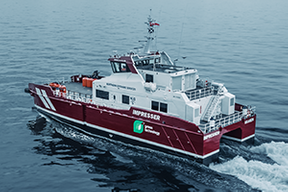Billions in Lost Treasure: How Modern Technology Is Revealing Hidden Riches from the Depths!
Oceans worldwide hold untold riches hidden beneath the waves. Now treasure hunters are using cutting-edge technology to explore them, discovering some of history's most treasured sunken finds from Caribbean waters to Arctic depths rewriting maritime history and uncovering fortunes lost at sea.
According to estimates by marine archaeologists and treasure hunting experts, the value of treasure lying beneath the waves could range anywhere between $60 billion to over $100 billion. Their calculations are based on historical accounts of sunken ships like colonial-era galleons carrying New World gold; warships hauling spoils of war; merchant ships transporting valuables around the globe - among many others
Over the centuries, thousands of ships have perished due to storms, pirate attacks, naval battles and navigational mishaps. European powers accumulated immense wealth during this golden era of seafaring from Americas, Africa and Asia that they transported back home leaving an abundance of treasure on the seafloor that modern explorers are eager to unlock and uncover.
Due to advances in deep-sea exploration technologies, some of history's most astounding treasure finds have taken place over recent decades. One such remarkable and lucrative find was that of the Nuestra Senora de Atocha galleon which sank off Florida coast in 1622, carrying with her from South American mines an extraordinary haul of gold, silver, and emeralds that totaled $450 million worth of treasure: 40 tons of gold/silver/coins plus 114,000 coins plus over 1000 emeralds! In 1985 treasure hunter Mel Fisher finally located it after years of searching and recovered its$450 million treasure, among the haul being 40 tons of gold/silver/coins plus over 1000 emeralds!
Odyssey Marine Exploration made one of the greatest discoveries ever in 2007 when they found the Black Swan treasure, also known as Nuestra Senora de las Mercedes, which had been sunk by British naval forces in 1804. Odyssey recovered over $500 million worth of silver coins during the expedition - making this discovery one of the largest recoveries ever undertaken at sea – the discovery sparked a lengthy legal dispute with Spain who ultimately acquired ownership.
The SS Central America, commonly referred to as the "Ship of Gold," was a steamer which sank off South Carolina during a hurricane in 1857 carrying tons of gold from California's Gold Rush and contributing to widespread financial distress in America. Treasure hunters eventually located its wreck, recovering over $100 million worth of bars and coins from it in 1988.
Unfound Treasures
In spite of amazing discoveries, many of the world's most celebrated shipwrecks remain missing; representing an untapped treasure trove for treasure hunters. One such ship is San Miguel from Spain's Treasure Fleet that was wrecked during a hurricane off Florida coast in 1715; some wrecks from this fleet have since been located; however, the San Miguel which reportedly carried enormous quantities of gold and silver remains lost.
Flor de la Mar is another prize that remains missing after it sank off Sumatra coast in 1511 carrying an immense treasure from Malacca Sultanate. Believed to contain gold, silver and jewels captured during its conquest.
The San Jose is yet another lost prize, having sunk off of Colombia during a battle between Britain and Spain in 1708. Carrying an estimated $17 billion worth of gold, silver, and emeralds from South America to Spain when she went down, makes this shipwreck one of the world's most valuable unrecovered treasures. Although located by Colombian officials in 2015, most of her treasure has to be recovered due to legal disputes regarding ownership.
Today, Technological innovations like sonar, underwater drones, remote operated vehicles (ROVs), and satellite imagery have revolutionized deep-sea exploration allowing treasure hunters to reach depths once inaccessible for exploration of wrecks or reefs that hold riches buried within.
Side-scan sonar is one of the primary tools used in searching for shipwrecks, providing researchers with detailed images of the ocean floor that allow them to detect anomalies that could indicate wreckage. When an anomaly is identified as potentially being wreckage-, then underwater drones and ROVs may be deployed as these remotely controlled robots can capture HD imagery or video, even in some cases coming equipped with manipulators capable of recovering objects from the wrecks remains.
Magnetometers are another essential tool, used to detect variations in Earth's magnetic field caused by large concentrations of metal likely found in shipwrecks -which alter its magnetic properties. When combined with sonar systems, treasure seekers can pinpoint exact locations of sunken vessels.
Satellite technology has also become an invaluable asset when it comes to treasure hunting, offering clues as to where wreckage or debris fields have moved over time. Some treasure hunters use historical satellite images of hurricanes or storms which might have caused ships to sink - further narrowing search areas.
Treasure-Rich Waters
Around the World Certain regions of the world's oceans are notoriously abundant with treasure-filled wrecks, drawing the interest of treasure hunters and marine archaeologists alike. Of particular note is the Caribbean Sea; as it served as a major route for Spanish treasure fleets returning home from America via Florida, Cuba, and the Bahamas - leaving wrecks from these fleets behind such as 1715 Fleet which was severely damaged during a hurricane.
Indian Ocean waters are notorious for hiding vast riches, with treasure ships such as Flor de la Mar and other East India Company vessels being lost due to storms or battles. Southeast Asia was an important trading center between Europe, Asia, and Middle Eastern during colonial rule, so many treasure wrecks may lie hidden here as well.
The Atlantic Ocean off of the east coast of the United States has long been known for its treasure hunting activity. Explorers come to search wrecked ships like the SS Central America and merchant vessels lost during World War II that have come aground there. Additionally English Channel and Mediterranean Sea waters were heavily trafficked by merchant and military vessels for centuries - both providing prime hunting grounds.
Estimating the Total Treasure Recovered Since WWII
While it is impossible to precisely determine the total treasure recovered since World War II, treasure hunters and marine archaeologists believe it may exceed over $2 billion worth of sunken gold, silver, and other valuables since 1945, this includes large scale discoveries like Atocha, Black Swan, SS Central America as well as numerous smaller discoveries made by individual divers and expeditions.
This figure ($2 Billion) likely represents only a fraction of the true worth of sunken sea treasures that remain concealed below the waves. With new technologies providing opportunities for deep-sea exploration and many of history's iconic treasure ships still waiting to be uncovered, sunken sea treasure hunting remains an obsession among both adventurers and historians alike.
As long as the oceans continue to guard their secrets, the dream of recovering a fortune from the deep will endure—driving treasure hunters to brave the unknown in search of lost wealth.















